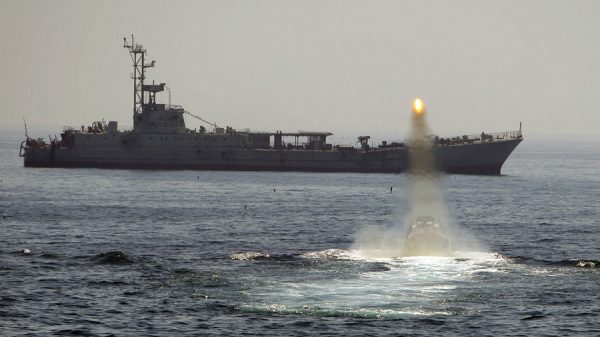
Iranian warships are set to leave the waters of the Persian Gulf to sail across the world and tour another gulf—the one that lies between the U.S. and Mexico.
At a time when Iran is looking to expand and modernize its military in the face of what is seen as a growing U.S. threat, its newly appointed navy commander, Rear Admiral Hossein Khanzadi, held his first press conference Wednesday, announcing that a fleet of Iranian ships would soon depart for the Atlantic Ocean and the Gulf of Mexico en route to visits to a number of South American countries, Iran’s semiofficial Tasnim News Agency reported. The move is reportedly part of a push to project Iran’s military on a more global scale and establish international ties as President Donald Trump and his allies, including Israel and Saudi Arabia, seek to isolate the revolutionary Shiite Muslim power.
“Sailing in open waters between Europe and Americas should be the navy’s goal, which will be realized in the near future,” Rear Admiral Habibollah Sayyari, who served as navy chief for 10 years before being assigned by supreme leader Ayatollah Ali Khamenei to deputy coordinator of the army, said earlier this month at his successor’s ceremony, according to the Tasnim News Agency and translated by Caspian News.
Khanzadi also pledged to introduce new vessels and submarines next year and announced other upcoming plans to bolster the country’s naval power. He said the new Peykan-class missile-launching corvette Separ (shield) would join the country’s Caspian Fleet next week. In addition to the planned reintroduction of refurbished and renovated vessels, a new navy airport was reportedly set to be under way in the southeastern port city of Jask, along the Makran coast.
Since the 1979 Islamic Revolution deposed West-installed Shah Mohammad Reva Pahlavi, the U.S. and Iran have had poor relations. The U.S. has also firmly backed its main Arab ally, ultraconservative Sunni Muslim kingdom Saudi Arabia, in a decades-long struggle to limit Iran’s influence. That campaign has become increasingly hostile in recent years, with both sides backing opposing political and militant movements across the region. As Iran outmatched its foe in crucial arenas, Israel has offered to help Saudi Arabia constrain Iran’s expanding foothold.
Trump, a staunch supporter of both Israel and Saudi Arabia, has decertified and threatened to scrap a 2015 Iran nuclear deal negotiated by his predecessor, former President Barack Obama. The agreement, which hardline conservatives in both the U.S. and Iran opposed, freed billions of dollars of sanctioned Iranian assets in exchange for Tehran promising to curb its nuclear production. Despite deep criticism from U.S. allies and international bodies that have found Iran to be in compliance with the deal, Trump has left it up to Congress to decide whether to kill the treaty or renegotiate, something Iran said it was not willing to do.
Despite the U.S., Israel and Saudi Arabia’s moves, Iran has found itself in a leading position in the Middle East, where it has claimed allies in the capitals of Lebanon, Iraq, Syria and Yemen. It has also built stronger ties with Russia, which was engaged in its own renewed Cold War with the U.S. and Western military alliance NATO in Europe, over the two countries’ mutual support for Syrian President Bashar al-Assad. This foreign support was crucial in helping Syria’s armed forces overcomea long-running uprising by jihadis and insurgents, which had received backing from the U.S., Gulf Arab states and Turkey. With the opposition now largely decimated, Turkey has joined Iran and Russia in administering peace talks.
Iran’s latest move toward the Western hemisphere isn’t its first. In addition to receiving ongoing political support from friendly Latin American nations, some of which were alleged to host elements of the Iran-backed Lebanese Shiite Muslim movement Hezbollah, Iran said in 2014 it would send warships into the Gulf of Mexico to protest the U.S. Navy presence in the Persian Gulf, according to USA Today.
Prior to that, Iran offered to dispatch experts during the massive BP oil spill in 2010 to “curb the rig leakage in the Gulf of Mexico and prevent an ecological disaster in that part of the world,” Reuters reported.
Click to see the comparison : Military power of USA and Iran
NEWSWEEK

Leave a Reply
You must be logged in to post a comment.